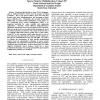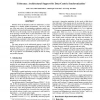88 search results - page 13 / 18 » Memory models: a case for rethinking parallel languages and ... |
WCE
2007
13 years 7 months ago
2007
—Partitioned global address space (PGAS) languages, such as Unified Parallel C (UPC) have the promise of being productive. Due to the shared address space view that they provide,...
VEE
2009
ACM
14 years 1 months ago
2009
ACM
r of high-level languages lies in their abstraction over hardware and software complexity, leading to greater security, better reliability, and lower development costs. However, o...
HPCA
2007
IEEE
14 years 7 months ago
2007
IEEE
With the advent of ubiquitous multi-core architectures, a major challenge is to simplify parallel programming. One way to tame one of the main sources of programming complexity, n...
BIRTHDAY
2004
Springer
14 years 3 days ago
2004
Springer
CSP was originally introduced as a parallel programming language in which sequential imperative processes execute concurrently and communicate by synchronized input and output. The...
LCPC
1998
Springer
13 years 11 months ago
1998
Springer
Although SIMD (Single Instruction stream Multiple Data stream) parallel computers have existed for decades, it is only in the past few years that a new version of SIMD has evolved...


